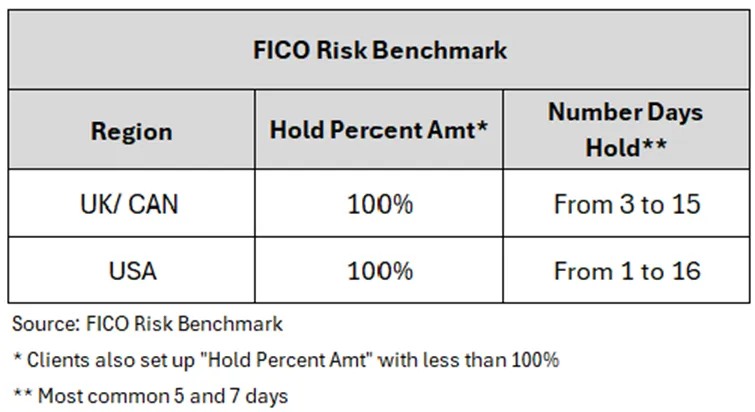Key Considerations to Manage Bust-Out Fraud and Check Kiting
Improve customer management and reduce losses from check fraud by managing payment hold strategies using analytics

While fraud teams and specialists work tirelessly to tackle ever-changing fraud cases, it’s important to note that customer management teams are also actively supporting the cause. There is particular focus on fraud cases related to deceptive payments made by supposed “trustworthy” customers. These cases are known by several different names, including bust-out fraud, check kiting fraud, or “ghost funding”.
What Is Bust-Out Fraud?
Bust-out fraud typically involves fraudsters establishing what appears to be normal usage and repayment patterns for a revolving line of credit, before maxing out the limit with no intention to repay. A variation of bust out-out fraud, known as check kiting, involves fraudsters intentionally depositing bad checks after large purchases, and subsequently withdrawing from the provisional credit limit and/or making additional purchases before the payments are inevitably declined due to insufficient funds (NSF). In many instances, this allows for the account balance to double the original line of credit, and the losses are categorized as bad debt because they are not flagged as fraudulent.
The Impact of Bust-Out Fraud
A recent survey found that bust-out (credit card) and check fraud rank as the first and fourth leading fraud types experienced by financial organizations (by case volume; second and third are account takeover and identity theft, respectively), spanning across enterprise banking, mid-market banking, and fintech. In fact, 31% of financial institutions face total fraud losses exceeding $1M. A recent article published by The Financial Brand also reports that a major U.S. financial institution suffered from this “infinite money glitch”.
How to Manage Bust-Out Fraud
Customer Management Technology
The ability to host and execute automated real-time payment hold (also known as “payment float”) strategies is a crucial part of addressing bust-out fraud.
Payment Data
Valuable datapoints are attached to every payment that is made. For instance, information on the payment source is critical in assessing the legitimacy and reliability of incoming funds. Guaranteed payment methods, such as cash deposits or certified checks, typically indicate genuine payment behavior and carry minimal fraud risk. Confirmed fraudulent payment transactions are equally important datapoints to collect and leverage to drive strategy and operational improvements.
Analytics-Driven Strategy
Within a payment hold strategy, two levers play an important role: the payment amount to hold and the duration to hold the payment. If an account is flagged with an at-risk payment, the appropriate action would be to withhold a percentage of the incoming payment and only restore the available credit after a few days have passed. Note that low-risk customers should not be unnecessarily impacted by broad risk controls.
The thresholds for the two levers should be determined using analytics. Even a simplistic evaluation of the day differential between the payment date and the payment posted date can be surprisingly useful. By looking at the distribution of this differential, it can provide a good proxy of the time it takes for payments to clear. If perhaps 80% of all payments clear by day 5, 90% by day 6 and 98% by day 7, then a seven-day hold action is appropriate.
It is also a best practice to track strategy performance, as well as have a champion/challenger framework in place to continuously test and learn with various strategy enhancements using new datapoints, segmentations, and/or thresholds for the levers.
Goal Setting: Balance Risk Treatment and Customer Experience
Establishing an appropriate risk appetite is key to delivering personalised customer experiences while balancing fraud prevention. For instance, maintaining a tolerable fraud capture rate or false positive ratio without exceeding a certain hold rate of all payments made.
Case Study: Challenger Strategies for a Mid-Tier U.S. Bank with Differing Goals
For those who are benefiting from FICO’s customer management technology, such as the FICO® Platform, financial institutions commonly place a hold on the entire payment amount for a period of 5 to 7 days.

In one instance, the FICO® Partner Success Advisors team collaborated with a mid-tier U.S. bank to develop two data-driven challenger strategies that leveraged the FICO® Behavior Score, account tenure, and trended attributes (such as account delinquency and payment/NSF patterns).
Each strategy offered two very different approaches: one with minimal impact to the customer, one with maximum capture of bad payments (by amount). The conservative strategy is expected to avoid 25.8% of bad payment amounts while only holding 1.4% of total incoming payments, whereas the more aggressive strategy is estimated to prevent 53.7% but at a higher payment hold rate of 6.1%. Both strategies included a 100% hold on the payment amount for up to 5 days.

How FICO Can Help
Reach out to your designated FICO® Partner Success Advisor or sales executive today if you are interested in hearing more about bust-out fraud prevention or similar customer management topics. Learn how FICO® Platform can help your business optimize credit lifecycle strategies through automation and analytics.
Thanks to my colleague See Tong Lim, who co-authored this post.
Learn More About Bust-Out Fraud
Popular Posts

Business and IT Alignment is Critical to Your AI Success
These are the five pillars that can unite business and IT goals and convert artificial intelligence into measurable value — fast
Read more
FICO® Score 10T Decisively Beats VantageScore 4.0 on Predictability
An analysis by FICO data scientists has found that FICO Score 10T significantly outperforms VantageScore 4.0 in mortgage origination predictive power.
Read more
Average U.S. FICO Score at 717 as More Consumers Face Financial Headwinds
Outlier or Start of a New Credit Score Trend?
Read moreTake the next step
Connect with FICO for answers to all your product and solution questions. Interested in becoming a business partner? Contact us to learn more. We look forward to hearing from you.
